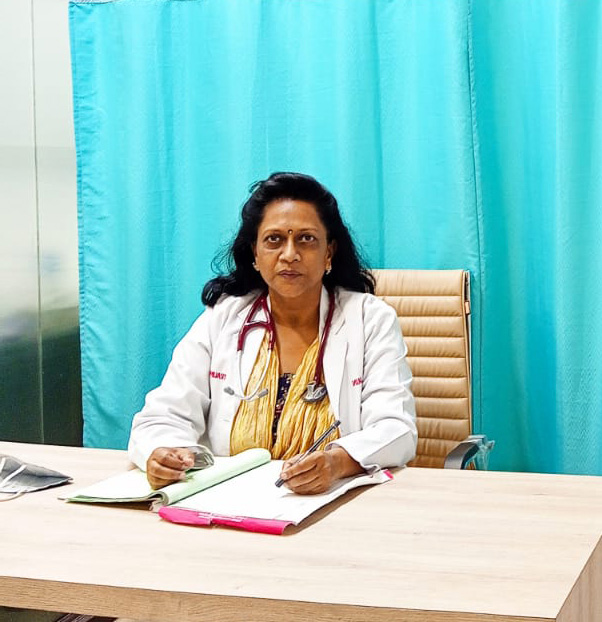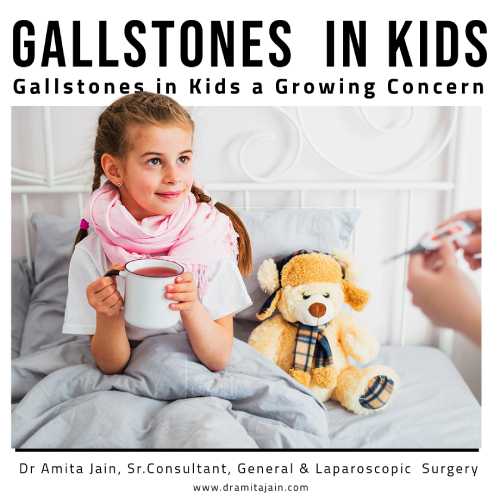In today’s fast-paced world, our busy schedules and numerous responsibilities can make it challenging to prioritize healthy habits. However, neglecting our well-being can lead to serious consequences. It is extremely important to take care of our health from the very beginning to avoid a range of negative outcomes.
This is especially true for children, as their health sets the foundation for their future well-being. One rising concern in pediatric health is the increasing frequency of gallstones in children over the past few decades. You might wonder how children are affected by gallstones.
Delhi’s renowned laparoscopic surgeon and gallbladder stone specialist Dr Amita Jain, explains the topic in this article.
What are Gallstones? How are they Formed?
The gallbladder is a pear-shaped organ located under the liver on the right side of the body. It stores bile, a fluid produced by the liver that aids in digesting fats. Bile consists of water, cholesterol, fats, salts, proteins, and bilirubin, a yellowish pigment.
Gallstones form when substances in bile, primarily cholesterol, harden into small, stone-like objects. These stones can obstruct bile flow through the ducts connecting the gallbladder, liver, and intestines. If a gallstone blocks a duct, it can cause swelling of the duct or gallbladder, potentially leading to serious complications such as organ damage, infection, or pancreatitis.
Therefore, managing gallstones is crucial to prevent these health risks associated with bile duct blockage.
What are the Types of Gallstones?
There are two primary types of gallstones that can develop:
Cholesterol gallstones: These form when the bile in the gallbladder cannot dissolve all the cholesterol the liver produces. Initially, this leads to the accumulation of substances known as gallbladder sludge, which eventually solidifies into stones.
Cholesterol gallstones are prevalent among adults and result from bile mixing with cholesterol and solidifying.
Pigment gallstones: These occur due to an excess of pigment, such as bilirubin, in the bile. Bilirubin is a natural byproduct of the body’s breakdown of red blood cells.
Pigment gallstones are more common in children, especially those with conditions that lead to increased bilirubin levels.
They form when bile contains excessive bilirubin, leading to the formation of solid stones in the gallbladder.
What Causes of Gallstones in Children?
Usually, girls are at a higher risk of developing gallstones than boys.
- Premature birth with low birth weight
- Spinal injury
- History of abdominal surgery
- Cystic fibrosis
- Hemolytic anemia
- Sickle-cell anemia
- Impaired immune system
- Use of intravenous nutrition
- Family history of gallstones
What are the Symptoms?
Gallstones often do not cause symptoms, but when they do, children may experience:
- Pain in the upper right or middle part of the belly, just below the rib cage
- Pain that feels sharp, crampy, or dull and can spread to the back or right shoulder
- Pain that comes and goes, worsening after eating, especially foods high in fat
- If a gallstone blocks a duct, additional symptoms may include:
- Nausea or vomiting
- Fever, chills, or sweats
- Jaundice, which causes the whites of the eyes or skin to turn yellow
A doctor must be consulted if a child develops intense abdominal pain or jaundice.

What is the Diagnosis for Children?
To diagnose gallstones in children, doctors use several methods:
- Physical Examination and Medical History: Initial assessment involves checking symptoms and medical history.
- Abdominal Ultrasound: This test uses sound waves to create images of the gallbladder and surrounding organs.
- Specialist Imaging:
- MRCP (Magnetic Resonance Cholangiopancreatography): Provides detailed images of the bile ducts.
- ERCP (Endoscopic Retrograde Cholangiopancreatography): Locates and can sometimes remove gallstones.
- HIDA Scan: Assesses the function of the liver, gallbladder, and bile ducts.
- Blood Tests: Checks for infection, jaundice, or other related issues.
Sometimes, gallstones are discovered incidentally during examinations for other issues or stomach pain.
How about the Treatment?
In most cases where children develop gallstones, a cholecystectomy, or gallbladder removal, is necessary to prevent the recurrence of gallstones. This surgery is often performed laparoscopically, using smaller incisions, which allows for quicker and more comfortable recovery.
Without the gallbladder, bile from the liver flows directly into the intestine. In some instances, gallstones may redevelop in the bile duct after the gallbladder has been removed. If this occurs, an endoscopy may be performed to remove the gallstone. This procedure involves passing a flexible tube through the mouth, stomach, and intestine to reach and extract the stone from the bile duct.
Thus, it is important to prioritize children’s health by recognizing and addressing gallstones early. Proper diagnosis and timely treatment can prevent serious complications, ensuring children maintain a healthy foundation for their future well-being.

Dr Amita Jain is a surgeon with highest degree of professional competence, precision and surgical craftsmanship. Performed all complicated general surgery procedures with in depth knowledge of invasive and few minimal invasive and onco surgical techniques. Underwent special training in trauma, executed various trauma-related complex life-saving neurosurgical procedures, reconstructed injured mangled limbs and performed vascular and reconstructive procedures with critical care.
Dr Amita Jain holds 28 plus years of rich experience in Trauma and General Laparoscopic Surgeries (including Gallbladder stone removal, appendix removal, hernia repair surgery, piles and fissure surgeries). She was the Professor Surgery of at the Army College of Medical Sciences and Base Hospital Delhi Cantt. In 1994 she was commissioned as Surgeon under the United Nations Mission in Congo. From 2020 to 2022, she worked with Bansals Hospital. Currently, Dr Amita Jain is the Senior Consultant, (Speciality: General and Laparoscopic Surgeon) at Artemis Lite Hospital, New Delhi
